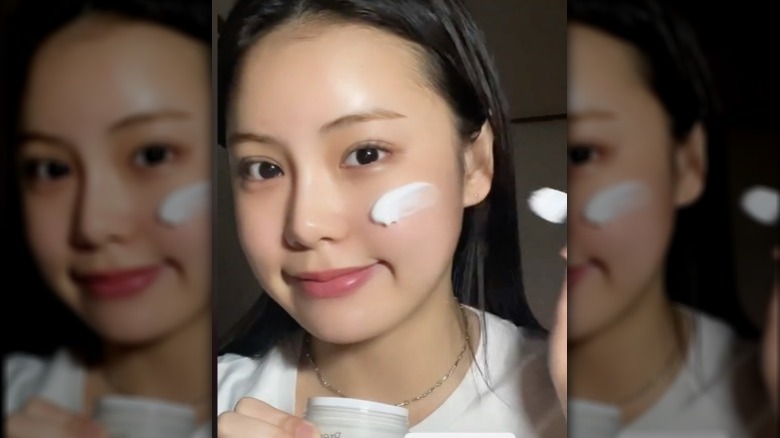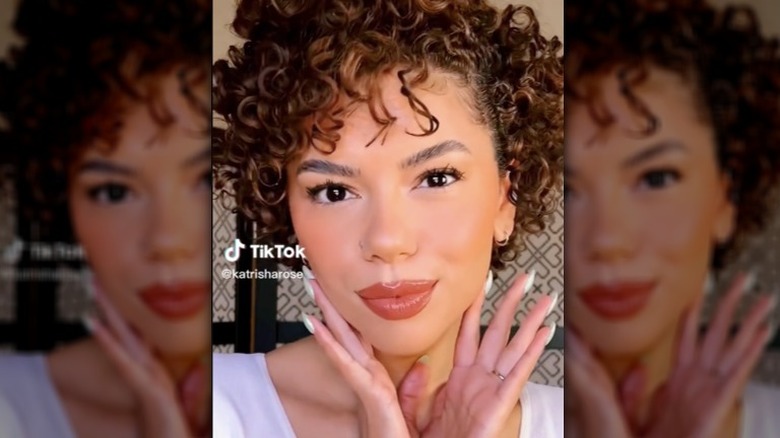Satin Skin Is Dethroning The Glass Trend As A More Universal Option
We may receive a commission on purchases made from links.
The world of skincare has been booming as of late, and social media platforms are at the forefront. TikTok especially is driving skincare trends and hyping up the necessary products to achieve them. Glass skin, for example, is one trend that nearly everyone has wanted to achieve at some point. "Glass skin is a term for exceptionally smooth, even-toned and lustrous skin that's so flawless it has the appearance of glass, " K-beauty expert Jude Chao told Dermstore. "It's simply a clear and elegant way of describing a certain type of enviable complexion." Glass skin is moisturized, youthful, and glowy and requires cleansers, exfoliants, toners, serums, and moisturizers all aimed at removing bumps, texture, and dark marks.
Though this skincare trend has been popular, nothing can reign forever on the internet. Glass skin can be hard to achieve because of pores, fine lines, and wrinkles, and the trend can actually emphasize texture. And for some, it can look more oily than dewy. But this doesn't mean the pendulum is swinging to matte complexions. In fact, another skincare trend, satin skin, is on the rise. "The satin finish is what I consider the most universally flattering for all skin types, and it's the most wearable every day," makeup artist Sébastien Tardif explained to PureWow. Of course, you can't achieve this without the right products, so here's what you need to add to your skincare arsenal.
What is satin skin?
Satin skin is more akin to natural skin. It falls between the glossy finish of glass skin and a matte finish. Glass skin was all about that dewy complexion and the appearance of a perfectly even skin tone. However, for many, that trend only highlighted pores or made them appear more prominent. And matte skin can make your complexion look dry and flat. Instead, satin skin is meant to highlight your natural complexion without the finish being too far toward one of the extremes. Have you heard of the viral "glazed donut" skincare trend? It's kind of like that.
Moisturize always
Of course, you can keep working your way to clearer skin, but satin skin is a little more forgiving as it doesn't rely on the flawless, dewy finish. Regardless of how much makeup you wear, you want to make moisturizing a priority to maintain healthy skin. For those fighting oily skin, look for water-based products, which tend to be lighter and can prevent clogging (via Healthline). Hyaluronic acid and glycerin are lightweight ingredients that still provide plenty of moisture. Oil-based, on the other hand, is better for dry skin.
Sunscreen protects your complexion
The goal of satin skin is to highlight a natural look, but you also want to protect it. Sunscreen can prevent new dark spots and aid in your efforts to fade any current ones. There are several factors to consider when choosing the best sunscreen for your skin, but you'll want to look for one with a clear formulation so it won't interfere with the satin finish you're trying to achieve. One that is silicone-based can be helpful for both oily and dry skin and can give you a primer-like finish if this is the step you want to stop at.
Add a little glow
The key to satin skin is finding that balance between matte and dry and glossy and dewy. Consider a hydrating mist to give your skin a gentle glowy boost without putting on a heavy layer of product. Or, reach for a light liquid luminizer or glowy highlighter stick for your cheekbones and the tip of your nose to create a natural-looking glow.
Blur out blemishes
Satin skin is less about creating perfection, so you won't need a full face of heavy products. Instead, opt for lightweight makeup that will cover and blur blemishes. Try a skin tint that glides on and stays on, like Fenty Beauty's Eaze Drop Blurring Skin Tint. A tinted moisturizer can also be a good option because they're sheer, so it won't feel caked on your complexion.





